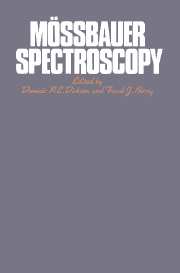Book contents
- Frontmatter
- Contents
- List of contributors
- Preface
- 1 Principles of Mössbauer spectroscopy
- 2 Mössbauer spectroscopy and the chemical bond
- 3 Mössbauer spectroscopy as a structural probe
- 4 Mössbauer spectroscopy of magnetic solids
- 5 Time-dependent effects and relaxation in Mössbauer spectroscopy
- 6 The dynamics of nuclei studied by Mössbauer spectroscopy
- References
- Index
4 - Mössbauer spectroscopy of magnetic solids
Published online by Cambridge University Press: 15 October 2009
- Frontmatter
- Contents
- List of contributors
- Preface
- 1 Principles of Mössbauer spectroscopy
- 2 Mössbauer spectroscopy and the chemical bond
- 3 Mössbauer spectroscopy as a structural probe
- 4 Mössbauer spectroscopy of magnetic solids
- 5 Time-dependent effects and relaxation in Mössbauer spectroscopy
- 6 The dynamics of nuclei studied by Mössbauer spectroscopy
- References
- Index
Summary
Introduction
The aim of this section is to begin with the most general and qualitative picture of the interactions of a Mössbauer nucleus with its environment. By developing and quantifying the treatment of these interactions, we seek to establish connections between the components of the environment and the energies of the nuclear levels and thus to build up an understanding of the features of the environment that shape the Mössbauer spectrum.
Classes of interaction
A schematic picture of the interactions that affect the energy levels of a Mössbauer nucleus is shown in Figure 4.1. In this representation it is seen that the Mössbauer nucleus senses its environment directly through atomic–nuclear interactions [1], solid–nuclear interactions [3] and the external field–nuclear interaction [5]. It is indirectly sensitive to the solid–atom interaction [2] and the external field–atom interaction [4], which are felt through their effect on the nucleus' own atom.
It is usual in magnetic solids for the main influence on the Mössbauer spectrum to be felt through the interactions [1] and [2]. That is, the nucleus senses its own atom and the state of the solid via the effect of the solid on that atom.
- Type
- Chapter
- Information
- Mössbauer Spectroscopy , pp. 143 - 197Publisher: Cambridge University PressPrint publication year: 1986
- 14
- Cited by

